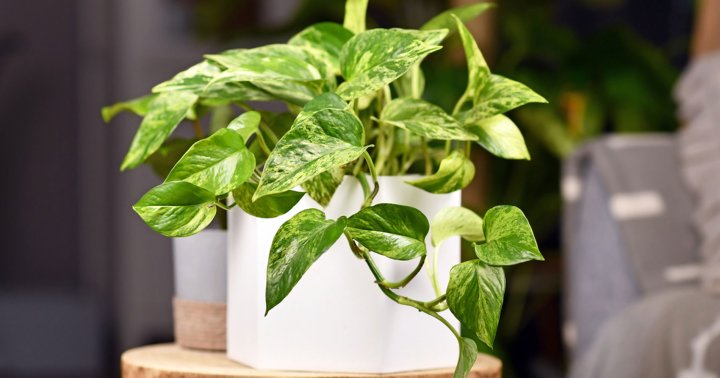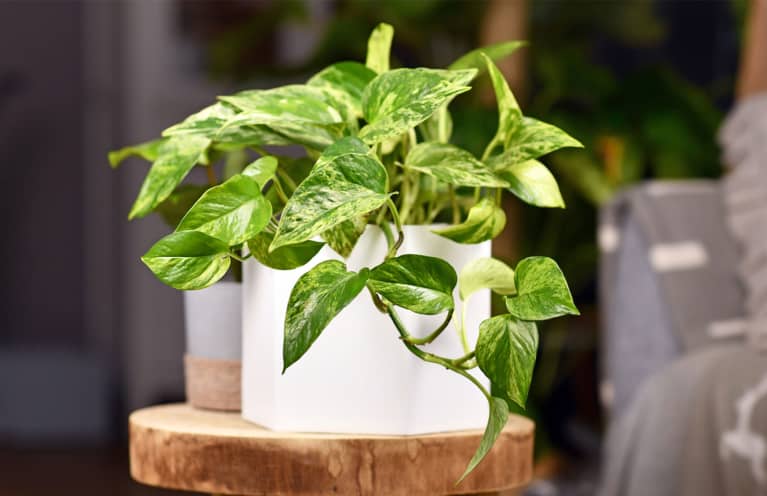This Houseplant Can Thrive Almost Anywhere & Grows Up To 20 Feet Long
Forgot to water while on vacation? NBD.


Our editors have independently chosen the products listed on this page. If you purchase something mentioned in this article, we may earn a small commission.
April 27, 2022 — 11:38 AM
Golden pothos (Epipremnum aureum) is an incredibly resilient and adaptable plant, making it a perfect choice for houseplant beginners—or anyone who wants a dramatic touch of green in their space. Here's what to know about this wonderful starter plant and how to care for it indoors.
Native to southeastern Asia, the golden pothos is a crafty vining plant, discernable by its heart-shaped yellow and green leaves. It's a type of pothos—a plant species that is now native to many tropical regions around the world. (Though it can be confused for a philodendron; read up on the difference here!)
Like most photos varieties, golden pothos really isn't picky and it can quickly spread just about anywhere. “It can grow, survive, and look well even in bathrooms, basements, or places without any natural light,” says Vladan Nikolic of the houseplant care blog, Mr. Houseplant.
When you have a happy golden pothos, there’s no telling how long this trailing plant will grow. “I have seen vines in peoples’ homes that are more than 20 feet long!” says Nika Linn, botanist and founder of Chez Flora, a Northern Colorado-based houseplant consultation service.
It also doesn't hurt that golden pothos are proven to be effective at clearing the air, so to speak. Just ask NASA.
You’re sure to find the wildly popular plant at your local nursery, home improvement store, or online without trouble.
The golden pothos is one of dozens of pothos varieties that can thrive as houseplants. Here are a few other popular ones:
Caring for the plant indoors.
If you haven't already realized, golden pothos is one tough plant! It can handle areas of lower light and long periods without water. “This plant has adapted itself so that it can literally grow in any place,” CEO of plant-centered lifestyle brand Live Long and Plant, Ellise Uyema tells mbg. “They can tolerate neglect very well.”
So while you don’t have to work too hard to minimize its conditions, even this houseplant has some living standards. Here's how to help it thrive in your space:
“While this plant does grow in low light, you’ll want to have more light exposure in order to keep the creamy golden color,” says Uyema. Bright, indirect sunlight will be ideal for your golden.
Give your pothos time to dry in-between waterings. Contrary to belief, Nikolic tells mbg that “you should never have a strict watering schedule.” Instead, hold off on watering until the top half of your plant's soil is dry to the touch. He adds you can also use a chopstick to get an idea of how wet or dry the soil is.
“Even though pothos is a plant that comes from a tropical area, it actually adapts very well to low humidity,” says Nikolic. As long as you aren’t keeping your home below 50-degree Fahrenheit, your pothos should be just fine.
Any well-draining potting soil that’s rich with nutrients will make a good home for your pothos houseplant.
Golden pothos is a fast grower and it can get squished (or root bound) if it stays in the same pot for too long. But being a little root bound isn’t always a reason to move it to a new pot. “Depending on how much the plant has grown, a plant can stay in the same pot for many years,” explains Linn, so you'll just want to look out for these signs that it really needs a new home.
When you do decide to repot, loosen up the root ball a little bit, and nestle it in a bigger pot with new soil. Stick to a pot that’s one to two inches wider. “You don’t want to get too big because then the plant is focusing on growing roots rather than leaves,” Savannah Toal, the founder of Plant Savvy, tells mbg.
Striking the right balance between fertilizing and repotting is also important for this plant. “If you’re repotting your plant once a year, it’ll get plenty of nutrients from the fresh new soil,” says Nikolic. While it's fine if you want to keep your plant in the same pot, you'll just want to add a little fertilizer every once in a while in that case.
Common problems & how to fix them.
Here are some common problems to look out for with your golden pothos and how to remedy them.
This pothos is incredibly easy to propagate in various mediums (water, soil, LECA, etc.). Propagating is a brilliant way to give your plant new life or gift a part of it to someone else. Here, our experts share the basics on how to propagate your golden pothos:
Step 1: Grab your gloves & prep your station.
“I’d recommend wearing gloves as the sap may cause an allergic reaction,” Uyema tells mbg. You'll also want to keep any curious dogs or cats away from your propagation station. Besides gloves, you’ll need a container, either a sharp knife or scissors, and well-draining soil or an alternative medium. (More on those below!)
Next, it's time to snip a few healthy leaves from your pothos to be propagated. “Make a cutting that includes at least one ‘node’ or growing point,” says Linn. Try to keep the cutting between three to six inches long, or however long it needs to be to keep at least two leaves.
Step 3: Place the cutting in your growing medium of choice.
Note: If you want a fuller plant, Linn suggests planting multiple cuttings together. You can even add in leaves from other pothos varieties for a more dynamic look.
Step 4: Transfer to soil.
After roughly two weeks, small white roots will start to form from your cutting. Unless you planted your cutting directly into soil in step three, this is your time to transfer your newly rooted plant into damp soil. Then, all that's left is to wait for growth!
Here are some final tips to keep in mind with this green beauty:
Golden pothos is tough, forgiving plant that makes a wonderful addition to any home. Whether you train it to climb up a window sill or let it hang above your bed, you can enjoy the greenery without worrying about being a bad plant parent. Because along with the almighty ZZ plant, this has got to be one of the all-time easiest houseplants to care for.
Want to learn how feng shui can help you create a high-vibe home and set powerful intentions to manifest your dreams? This is feng shui the modern way - no superstitions, all good vibes. Click here to register for a free session with Dana that will give you 3 tips to transform your home today!
Reset Your Gut
Sign up for our FREE doctor-approved gut health guide featuring shopping lists, recipes, and tips
You are now subscribed
Be on the lookout for a welcome email in your inbox!
https://www.mindbodygreen.com/articles/golden-pothos

 JaneWalter
JaneWalter 






























.jpg&h=630&w=1200&q=100&v=6e07dc5773&c=1)

